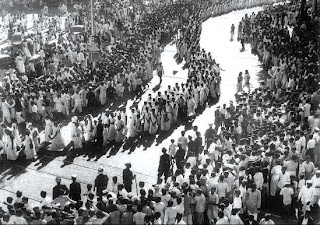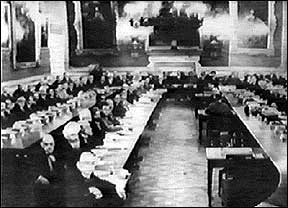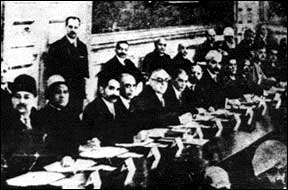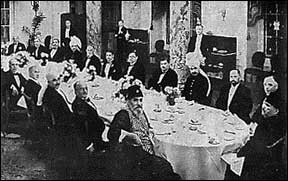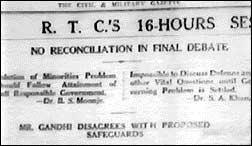Mahatma Gandhi timeline
Mar 1919
British Government Passes the Rowlatt Act in Colonial India, Indefinitely Extending the Use of 'Emergency Measures'
The Rowlatt Act was a law passed by the British in colonial India in March 1919, indefinitely extending "emergency measures" (of the Defence of... Read more
Apr 13 1919
Jallianwala Bagh Massacre
The Jallianwala Bagh Massacre (Hindi: जलियांवाला बाग़ हत्याकांड جلیانوالہ باغ Jallianwala Bāġa Hatyākāṇḍ), alternatively known as the Amritsar... Read more
Sep 1920
The Gandhi Era of the Indian Independence Movement Begins with the Non-Cooperation Movement
The non-cooperation movement (Hindi: असहयोग आन्दोलन), was the first-ever series of nationwide people's movements of nonviolent resistance and civil... Read more
Dec 1921
Gandhi is Given Exclusive Authority Over the Indian National Congress
In December 1921, Gandhi was invested with executive authority on behalf of the Indian National Congress. Under his leadership, the Congress was... Read more
Feb 1922
Nationalist Mob Sets Fire to a Police Station in Chauri Chaura Incident, Prompting Mahatma Gandhi to Call Off the Non-Cooperation Movement
On February 4, 1922, around 2,000 protesters gathered for picketing of the liquor shop at the local market in Chauri Chaura. Sensing the trouble,... Read more
Mar 10 1922
Gandhi is Arrested by the British Government on Charges of Inciting Violence at Chauri Chaura
The Government seized the opportunity for which it was waiting. On the evening of March 10, 1922, Gandhi was arrested in his ashram. The trial was... Read more
Feb 1924
Gandhi is Released from Prison After Serving Only Two Years of a Six-Year Sentence Following Surgery for Appendicitis
In February, after he had served only two years in jail, Gandhi, after an operation for appendicitis, was released. He did not, as his faithful... Read more
Sep 1924
Gandhi Begins Twenty-One Day Fast in an Attempt to Reconcile Hindus and Muslims
In September 1924, Gandhi went on a twenty-one day fast to "purify" himself and " to recover the power to react on the people." The fast had a... Read more
Sep 1925
Gandhi Founds the All-India Spinners' Association
During the next three years, while national politics were dominated by communal issues and controversies in legislatures, Gandhi retired from the... Read more
1927
Gandhi's 'The Story of My Experiments with Truth' is Published
The Story of My Experiments with Truth (Gujarātī "સત્યના પ્રયોગો અથવા આત્મકથા" transliterated: Satyanā Prayogo athvā Ātmakathā) is the... Read more
Dec 31 1929
Indian National Congress Raises the Tricolor Flag of India
In December 1928, Congress held in Calcutta, Mohandas Gandhi proposed a resolution that called for the British to grant dominion status to India... Read more
Jan 26 1930
Declaration of the Independence of India
The Declaration of the Independence of India was promulgated by the Indian National Congress on January 26, 1930, resolving the Congress and Indian... Read more
Mar 12 1930
Mahatma Gandhi Embarks on the Salt Satyagraha
The Salt Satyagraha was a campaign of nonviolent protest against the British salt tax in colonial India which began with the Salt March to Dandi on... Read more
Apr 6 1930
Mahatma Gandhi Arrives at Dandi, Gujarat, Concluding the Salt March
On March 12, 1930, Gandhi and 78 male satyagrahis set out on foot for the coastal village of Dandi, Gujarat, 390 kilometres (240 mi) from their... Read more
Mar 5 1931
Lord Irwin, Viceroy of India, Signs the Gandhi-Irwin Pact. Salt Satyagraha was suspended.
Gandhi–Irwin Pact refers to a political agreement signed by Mahatma Gandhi and the then Viceroy of India, Lord Irwin on 5th March 1931. before... Read more
Aug 29 1931
Gandhi Sets Sail for England to Represent the Indian National Congress at the Second Round Table Conference
On August 29, 1931, Gandhi sailed for England in the SS Rajputana to attend the Second Round Table Conference, He went as the sole representative... Read more
Dec 28 1931
Gandhi Arrives in Bombay After His Visit to Europe
While Gandhi was on the high seas, the arrests of Jawaharlal Nehru and Abdul Ghaffar Khan, two of his ablest lieutenants, had created a crisis.... Read more
Sep 1932
Gandhi Begins Six-Day Fast to Protest Separate Elections for Untouchables
A new twist to the civil disobedience movement came in September 1932 when Gandhi, who was in Yeravda Jail, went on a fast as a protest against the... Read more
Sep 17 1934
Gandhi Announces Retirement from Politics to Focus on Village Economics
In the summer of 1934, three unsuccessful attempts were made on his life. When the Congress Party chose to contest elections and accept power... Read more
Apr 30 1936
Gandhi Relocates Base of Operations to Sevagram, a Small Village Near Wardha in Central India
When the Congress Party chose to contest elections and accept power under the Federation scheme, Gandhi decided to resign from party membership. He... Read more
Mar 3 1939
Gandhi Announces Fast-Unto-Death in the Effort to Form a People's Council in Rajkot
Before the convening of the plenary session of the Congress Party at Tripuri on March 11, India watched with interest and alarm the struggle... Read more
Mar 27 1942
The Cripps' Mission
Upon his arrival in India, Cripps held talks with Indian leaders. There is some confusion over what Cripps had been authorised to offer India's... Read more
Aug 8 1942
The All India Congress Committee Launches the Quit India Movement
The "Quit India" resolution passed by the All-India Congress Committee brought it into a head-on collision with the Government in August 1942. The... Read more
Aug 9 1942
Gandhi is Arrested, Along with the Entire Congress Working Committee
World War II broke out in 1939 when Nazi Germany invaded Poland. Initially, Gandhi had favored offering "non-violent moral support" to the British... Read more
Aug 15 1942
Mahadev Desai, Gandhi's Personal Secretary, Dies From Heart Failure
Gandhi and the entire Congress Working Committee were arrested in Bombay by the British on 9 August 1942. Gandhi was held for two years in the Aga... Read more
← Previous 1 2 3 Next →

 ii) Influence of Swami Vivekananda : Vivekananda entered the life of Subhas Chandra when he was barely fifteen ,i.e., in 1911. It was Vivekananda who gave him a principl that he could cling to . When he was not in a position to decide his way the works of the Swamiji - the saffron- dressed Hindu monk of India became his life time. Protest or revolt against injustice was learnt by Subhas from Vivekananda. In 1913 when he was only 15 and passed Matriculation securing 2nd position in the University, a legendary figure Aurobindo influenced him by his patriotic action, sacrifice for motherland, and deeper philosophy.
ii) Influence of Swami Vivekananda : Vivekananda entered the life of Subhas Chandra when he was barely fifteen ,i.e., in 1911. It was Vivekananda who gave him a principl that he could cling to . When he was not in a position to decide his way the works of the Swamiji - the saffron- dressed Hindu monk of India became his life time. Protest or revolt against injustice was learnt by Subhas from Vivekananda. In 1913 when he was only 15 and passed Matriculation securing 2nd position in the University, a legendary figure Aurobindo influenced him by his patriotic action, sacrifice for motherland, and deeper philosophy. iii) Mentors of Subhas Chandra - 1. Swami Vivekananda, 2. Aurobindia, 3. Benimadhab Das
iii) Mentors of Subhas Chandra - 1. Swami Vivekananda, 2. Aurobindia, 3. Benimadhab Das
 Beni Madhab Das (Bengali: বেণী মাধব দাস) (1866 – 1952) was an erudite Bengali scholar, a renowned teacher and a great patriot in British India. Subhas Chandra Bose was his student at Ravenshaw Collegiate School and he left an inedible mark in the mind of his young student, as acknowledged in his book Bharat Pathik. When Bose was under internment and had decided to leave India, he wanted the blessings of his teacher, and so a clandestine meeting was organized for the purpose. A number of his other students occupied important positions in life. His personal life of dedication and devotion inspired all his students on to an eventful life. He was what was referred to as an exemplary teacher.
Beni Madhab Das (Bengali: বেণী মাধব দাস) (1866 – 1952) was an erudite Bengali scholar, a renowned teacher and a great patriot in British India. Subhas Chandra Bose was his student at Ravenshaw Collegiate School and he left an inedible mark in the mind of his young student, as acknowledged in his book Bharat Pathik. When Bose was under internment and had decided to leave India, he wanted the blessings of his teacher, and so a clandestine meeting was organized for the purpose. A number of his other students occupied important positions in life. His personal life of dedication and devotion inspired all his students on to an eventful life. He was what was referred to as an exemplary teacher.







